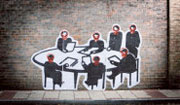 Transnational organized crime is increasingly on the agenda of the Security Council; Afghanistan, Central America, the Democratic Republic of Congo, Haiti, the Sahel, and West Africa are recent examples. As the Brahimi report on peacekeeping pointed out in 2000: “The United Nations must be prepared to deal effectively with spoilers if it expects to achieve a consistent record of success in peacekeeping or peacebuilding in situations of intrastate/transnational conflict.“
Transnational organized crime is increasingly on the agenda of the Security Council; Afghanistan, Central America, the Democratic Republic of Congo, Haiti, the Sahel, and West Africa are recent examples. As the Brahimi report on peacekeeping pointed out in 2000: “The United Nations must be prepared to deal effectively with spoilers if it expects to achieve a consistent record of success in peacekeeping or peacebuilding in situations of intrastate/transnational conflict.“
But how do you spot the spoilers? What is their motivation? What is their impact on peace processes, particularly in fragile states? And how do you measure the impact of organized crime?
Key Conclusions
The United Nations is becoming increasingly aware of the threat posed by transnational organized crime, and is concerned about its impact—not only on security, but also on development and the rule of law. However, it lacks guidelines to help assessors identify and analyze the threat posed by organized crime. This is dangerous, because failing to properly assess the threat posed by organized crime can jeopardize the security of UN staff and exacerbate the situation on the ground, due to a misunderstanding of incentives and networks.
In the recent publication Spotting the Spoilers (authored by Mark Shaw and me, Walter Kemp), we set out to create a guidebook for practitioners to identify warning signs of criminal activity in the theater where they are operating; assess the impact caused by organized crime; and prepare assessments which can be used by policy makers to take remedial action. Such a tool is essential if the UN is to more effectively prevent and control the growing threat posed by criminal groups. It can also be of interest—and of use—to a wider public who are interested in the issue, including policymakers, police and judicial officials, staff of development agencies, members of civil society, journalists and students.
Analysis
The United Nations does not need to gather intelligence on its member states, nor would its member states want that. Indeed, there have been heated discussions within the C-34 committee (which deals with peacekeeping) on even using the word “intelligence.” However, the UN needs to be aware of developments on the ground, not least —although not exclusively—in theaters where it has peace operations. Indeed, organized crime is a threat in almost every theater where the UN has peace operations: from Afghanistan to the DRC; from Kosovo to Haiti; from Guinea-Bissau to Somalia.
To figure out who the criminals are, their impact on society, and what to do about them, peace operations require detailed knowledge of the motivations and modi operandi of peace spoilers.
Several parts of the UN carry out threat assessments. The Integrated Missions Planning Process (IMPP) relies on an in-depth understanding of the specific country setting which is derived from a strategic assessment. But these assessments do not necessarily include an analysis of organized crime. Most UN peacekeeping missions have a Joint Mission Analysis Centre (JMAC) which carries out regular assessments, including on criminal threats. However, there are no JMAC equivalents within political or peacebuilding missions. This is a major lacuna.
The United Nations Office on Drugs and Crime (UNODC) produces periodic threat assessments, usually about regions (rather than countries) affected by transnational organized crime. UN panels of experts have carried out top-quality assessments—the DRC and Somalia are examples—but they are not, strictly speaking, about organized crime. Furthermore, on a case-by-case basis, the UN draws on available information from national law enforcement agencies and INTERPOL. This should be done more systematically, for example by plugging crime experts within UN field operations into the existing Interpol I/24 network.
Because they are becoming increasingly confronted by the problem of organized crime, UN staff—particularly in the field—need to better understand and react to the threat. Assessments of organized crime are vital for planning interventions, particularly technical assistance and criminal justice support, and for understanding the political economy of the situation. In short, analysis is the basis for effective remedial strategies.
The problem is that organized crime is hard to find; people who carry out illicit activities work to avoid detection. It is also a difficult phenomenon to address because criminals may not look like criminals; they may be high-level businessmen or politicians. Therefore, one needs to look at criminal markets, the incentives and causes of criminal activities, the players involved and their networks.
It is also essential to understand the impact of crime. After all, crime is not only a threat to security. It can have negative consequences on politics, social structures, the rule of law, the economy, and even the environment.
Walter Kemp is the International Peace Institute’s Director for Europe and Central Asia and co-author, with Mark Shaw, of Spotting the Spoilers: A Guide to Analyzing Organized Crime.




